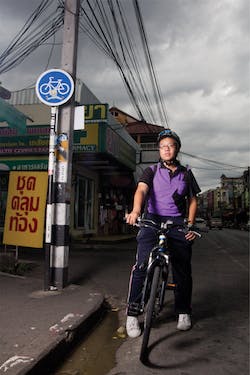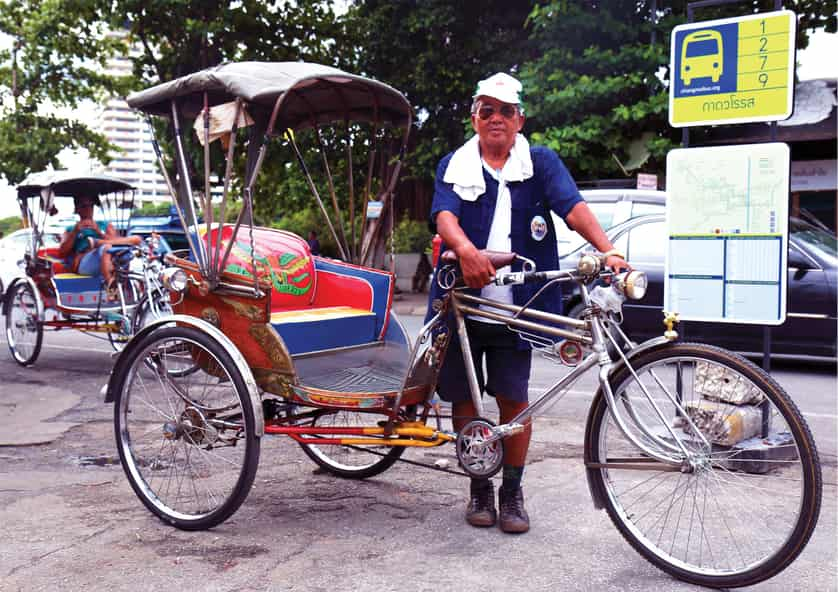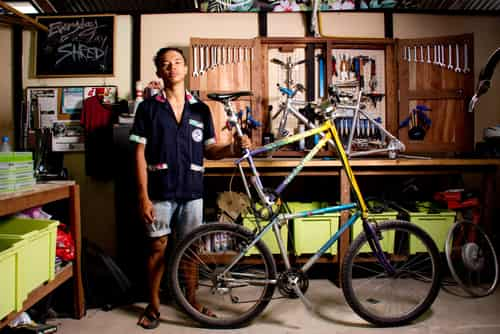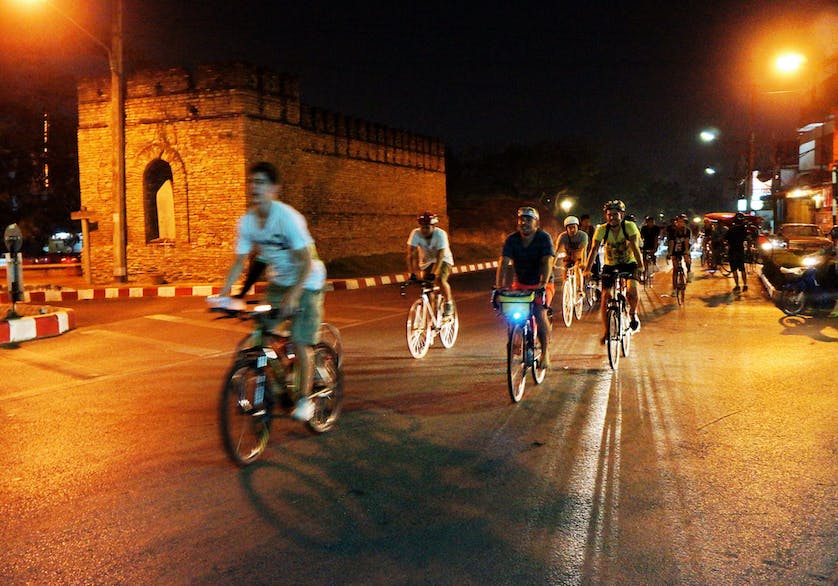The Chang Puak bicycle shop is not a busy place. Most of owner Pakin Buranapanich’s customers stop by to rent one of the scooters he keeps in his garage while Niwat, the shop’s mechanic, fine tunes the bicycle inventory. A cluster of vintage bicycles I spotted in the back of the shop motivated me to emerge from the suffocating traffic of Chang Puak road one evening, and Pakin instantly jumped to his feet.
“Very good, not expensive,” Pakin proclaimed while wheeling out the 1970s Japanese Oshima Sword that caught my eye. I took it for a test ride. I was sold.
Niwat worked fervently to repair the dynamo generator that powered the headlight so I could pedal safely into the night. Victoriously, he spun the wheel and clapped as the ancient bulb came to life with an amber glow.
I put my motorcycle on the back burner for a while. This was no easy task. I love my motorycle. My 1967 Yamaha YL2 is hopefully not, but probably is, the coolest thing about me. My Oshima Sword, however, makes creaking noises as I pedal, the steel rod brakes shriek wildly, and the dynamo generator emits a strange whir that grants curious glances as I pass.
There are others out there. Indeed, there are those that despite the heat and hordes of swarming vehicles that threaten their every movement like a cloud of angry hornets, choose to ride bicycles. If it’s not the obvious that deters one from going full pedal power, you’d think the recent tragic deaths of members of the San Sai Bicycle Group would. Still, there are those that take the road less traveled, so I decided to track down the ones that get around the good old fashioned way.
The Commuters
I enlisted a couple of Citylife interns to help me scout out some cycling road warriors that were braving the evening rush hour one humid evening. One by one we spotted brave souls weaving their way through the fumes and clinging to their precious few inches of roadside.
18-year-old Kachol Kaewpradit was one such commuter on his way home from Yupparaj Wittayalai high school. Decked in purple, and with sweat dripping down his helmet-clad head, he graciously stopped to chat with us under a scrap of shade.

“I’ve been cycling for three years, back and forth from school and all around Chiang Mai. Honestly, I think that riding a bicycle in Chiang Mai is dangerous. I don’t even like riding my bicycle, but I have to.”
“I don’t want to support more people riding bicycles, seriously,” he said. “There are lots of cars on the road, and it’s dangerous. Driving a car is the best choice.”
Ouch. Cars – 1, Bikes – 0.
Kachol, however, is obviously just being realistic. The Chiang Mai Municipal Tourist Information Centre has put together a very slick and comprehensive bicycle map that you can pick up at bicycle shops and coffee houses all over the city. Looking only at the map of routes, it may seem that Chiang Mai is an oyster to those with bicycles. However, once on the “bicycle lanes”, reality sets in. The lanes turn out to be nothing more than a bicycle symbol and an arrow painted in the middle of the road. Where this symbol is present, bicycles have the right to ride in the middle of the street. Cyclists like Kachol, however, seldom actually do out of fear for their safety, and the swifter traffic forces them over to their tiny sliver of pavement instead.
“From our point of view, bicycle lanes in the city are road spaces that are also used by other vehicles,” explained Montree Piyakul, director of the Chiang Mai Provincial Office of Tourism and Sports, during a rare moment where an authority picked up their phone and allowed us a brief moment to ask some questions. According to Montree, the Provincial Office of Tourism and Sports works along with a “committee for bike route construction” selected by the provincial government, who is advised by the municipality to develop bicycling solutions for the city.
“The municipality’s plan indicates that there will be five to six bicycle routes that will run through areas in the moat. The routes will be synchronised with the existing public bike stations. We intend to add bike lanes which allow only bicycles, with the exception of routes designated by the municipality where bicycles will have to share the road space with other vehicles.”
Montree did not have or share information regarding whether these “bicycle-only lanes” will be indicated by signs, paint, or a physical barrier. We asked if the added routes will resemble the bike routes that recently appeared around Three Kings Monument.
“It depends,” said Montree. “The green lanes are especially for bikes, it indicates that cars should not use this lane. In other areas where the municipality has designated, bicycles will have to use the main road with other vehicles, and sometimes they will have to use footpaths.”
From our conversation, although Montree didn’t explicitly state it, I got the impression that the Three Kings model, with bicycle lanes painted green, is as far as the city plans to currently go in terms of designating bicycle-only lanes. With Thai drivers’ notorious where-there’s-a-will-there’s-way driving style, I don’t expect that a lane painted green will deter motor vehicles from dominating this hard-earned space.
The People-Movers
If there’s anything that congests the streets of Chiang Mai and provides a constant obstacle to bicycle commuters, it’s the songtaews and tuk tuks.

There is another method to this madness. Another medium forgotten in the art of moving people around: the samlor, or, three wheeler. The samlor was supposedly invented by a naval officer in Nakhon Ratchasima province in the 30s by attaching extra wheels to his bicycle and for decades afterwards served as an iconic mode of transport throughout Thailand. The samlor, however, was eventually banned in the 60s in Bangkok because it was too slow, causing congestion and accidents, thus bowing out to let the motor vehicles dominate the roads. In Chiang Mai, the samlor is still present, and faithfully operated by people like Udom Srithongmuang who has been giving people rides for over 50 years.
“I’m 72 and I still like it. I like the independence, I can ride whenever I want. There’s no cost to me either, just my energy. It’s like I get to exercise with my friends in the Samlor Group every day. Normally, I make around 300 to 400 baht a day, but lately I’m making less because there’s fewer customers. Most of my customers are farang, but the Chinese seem to like tuk tuks more than samlor.”
As we chatted, two Western tourists walked by, slowing momentarily to examine Udom’s samlor.
“It looks kind of small,” one of them remarked, and then promptly waved down a songtaew which they boarded all to themselves.
Udom explained that the Chiang Mai International Rotary Club supports the samlor drivers every year by training them, offering them uniforms, providing samlor maintenance and helping them find new customers in efforts to keep the samlor business thriving in the area. Chiang Mai currently is home to 65 samlor drivers, with most of them congregating around Wararot Market.
In June of this year, the Chiang Mai Traffic Police announced the “Travel in Chiang Mai on Samlor” project which aided samlor drivers in establishing designated parking areas and helped them to establish new pick up and drop off points throughout the city.
Most samlor drivers in Chiang Mai have been driving for decades. If new drivers don’t pick up the reins after drivers retire, this icon of Chiang Mai could quickly fade out in the next few years. Internationally, rickshaws or pedicabs are seeing a dramatic increase in younger generations using them for full-time income. In the US, cities such as Seattle, Portland, Chicago and New York have seen a tremendous rise in the use of pedicabs. In the UK, London has seen their share of pedicabs increase dramatically over recent years from just 30 operating pedicabs to now around 1400. Internationally the pedicab has become an efficient and intelligent mode of public transportation that coincides with cities’ goals to combat pollution and promote sustainability.
The Activist
On a Friday evening under a grey sky hanging precariously close to rainfall, a cluster of cyclists have gathered on the iron bridge. I had been invited to witness an Alley Cats Race by 19-year-old Kan Kyi, organiser of the underground races, owner of Two Revolutions bicycle shop and all around fixture in the Chiang Mai bicycle scene.

“You gonna ride?” He asked me, but looking around at the aerodynamic road bikes clutched by the anxious riders, I decided that my Japanese grandma bike and I would sit this one out.
Around 15 cyclists arrived to brave the mist-coated asphalt on a route designated by Kan Kyi. From Charoen Muang Bridge around Nawarat Bridge up to Rattanakosin Bridge and back to the starting point. Racers will complete four laps, for a total of around 16km.
“The Alley Cats Races are fun,” Kan Kyi explains while examining a clipboard of participants, “but it’s also just a way for cyclists to be visible.”
The race lasted about an hour, the sky eventually opening up and pouring rain on the first three finishers as they held their prizes above their heads smiling; curious motorists stuck in Nawarat Bridge traffic looked on behind their car windows and helmet visors.
Kan Kyi is a Chiang Mai born local who has become an integral part of the local cycling community, and can be seen traversing Chiang Mai’s streets daily on his peculiar “tall bike”, a bicycle he constructed himself by combining two bicycle frames which allows him to ride about two metres off the ground.
“It’s a spectacle, it’s like the races- it’s just to be seen. I started organising critical mass rides as well, and that’s the same thing. I want to get it in peoples’ minds that there are bicycles on the road. People are always posting pictures of my bike online and stuff, and my friends say ‘Hey man, look you’re famous!’ I’m like, ‘Famous? I don’t really know what you mean, but if it gets more people riding, that’s cool.'”
You might say that because of Kan Kyi, more people are riding.
“I want to get my fingers into all communities,” Kan Kyi explains passionately. “First and foremost, it’s about getting people riding. You know, with things like critical mass, it’s like ‘look at all these people! You can do it too! That’s what I’m saying.”

Kan Kyi also believes that Thai people should be even more inspired by the fact that riding a bike follows the King’s Philosophy of Sufficiency Economy.
“I want bicyclists to know that they’re following this model of sustainability. That inspires me. And even one more person means a little bit bigger of a community striving towards this goal. All I can say is go get a bike. Ride a bike. Chiang Mai is flat. It’s easy, really! It’s following the motto of the King. Yo. You know? Let’s keep the community beautiful by following that.”
The Athlete
“Chiang Mai – I think this city has a lot of potential to change peoples’ ideas about bicycling,” muses Wisut Kasiyaphat, one of the most notable names in Thai professional cycling. “In Bangkok, it’s just too big and too hot, but in Chiang Mai we have four months that are great for riding, and that’s enough of a window to change peoples’ behaviour and use the bicycle more for their personal transport.”
Wisut doesn’t spend much of his time on a bicycle in the city. When Wisut is riding, it’s mainly in the hills and mountains surrounding Chiang Mai and its urban sprawl. Chiang Mai is a natural training grounds for cyclists providing a terrain conducive to any type of riding. For decades Wisut has been pedalling through the mountains developing his own routes and using them to train some of Thailand’s most talented cyclists for the Thailand National Team and Singha Infinite Cyling pro team.
“We have almost everything that cyclists need,” he says, “We have flat roads, we have different sizes of mountains; S, M, or L, if you want hills you can go for the Samoeng loop, if you want a 16km ride for Doi Suthep, if you want an XL size go to Doi Inthanon.”
“When I used to come out to the mountains 20 or 30 years ago, there was just people with mountain bikes. Now you go up to Doi Suthep and there’s hundreds of people with road bikes.”
Chiang Mai as an international destination for cycling athletes has definitely risen in popularity. But Wisut sees signs of cycling in Thailand increasing overall as well. Recently, there was so much interest in the nationwide “Bike for Mom” ride, which will be held in all 76 provinces on August 16th, that the website crashed in the first five minutes when it was launched for online registration. Wisut believes that events like this are a clear sign of the times.
“It might be 100,000, 200,000 people riding all over the country that day, who knows? Cycling in Thailand is going way up. A lot more than before.”
Wisut Kasiyaphat is also the founder and organiser of the Masters Tour Chiang Mai. A four day race that attracts cyclists from all over the world. Wisut has already seen registrations pouring in from Thailand, Malaysia, Indonesia, Singapore, Hong Kong and Taiwan.
“The bicycle- you have movement, you have a machine. You can play with the machine as your hobby. You can go so far, and if you pay attention and use the roads intelligently, you’re safe.”

The Road Ahead
Anyone who rides a bicycle around Chiang Mai’s city centre has probably observed scraps of what resemble bicycling infrastructure. The faded bicycle lane symbols, the crushed and broken LED lights outlining bike lanes on the inner moat avenues, the bizarre green bicycle lane spanning a not so impressive 20 or so metres down the road adjacent Three Kings Monument, and the blue circle bicycle lane signs that at most acknowledge cyclists’ existence. The city, in no short supply of new initiatives and projects like Chiang Mai Green City, Bike Chiang Mai, the Sustainable Urban Transport Project, and the Ride a Samlor in Chiang Mai project seems to be unable to advance beyond the point of intentions printed on banners or plans and documents that never yield long term results.

In a Citylife article published in January of 2014, an attempt was made to trace a grant that Chiang Mai was awarded by the Global Environment Facility (GEF) and implemented by the World Bank Thailand office in support of the Sustainable Urban Transport Project. I again tried to trace this grant and attempted to get some response from the municipal and the provincial offices. I could not track down where the money went exactly (over $2 million US), perhaps it went towards the bicycle lane out to Huay Tung Tao, which has received mixed reviews.
On a commute home on my Oshima Sword one evening, I was clocked. I looked both ways, twice, maybe three times, I had lights on, and a reflector on my arm I was given at the Alley Cats race, but despite my caution, a young girl on a Scoopy still managed to materialise and send me sprawling onto Santitham Road.
I was fine, and the young scooter driver was very apologetic. In Chiang Mai, aggression from motorists towards cyclists and vice versa does not seem to be as prominent as cities in the US, especially my hometown of Chicago. The people of Chiang Mai understand, I would say, that the bicycle can offer some sort of a solution to many of our city’s ailments. But the modern human being wants things fast, and now, and effortlessly.

I do not expect motor vehicles to decrease in any number, nor do I expect cycling to see a sudden increase in participation, but I do think that Chiang Mai cyclists need an opportunity to traverse the city in some sort of harmony with their motorised neighbours.
In a very brief response to the bicycling situation in Chiang Mai, Mayor Tassanai Buranupakorn expressed that he sincerely wants to promote bicycling for commuting purposes, and is seeing progress in small steps. There are no plans to install additional bike lanes in the city centre, he admits, because there is not enough space. The mayor informed Citylife that the city plans to unveil a fleet of six buses equipped with bike racks so bicyclists can use them to traverse problematic areas. He also offered the wooden bridges that have been added across the moat as a solution, and that these are routes that motorists are not able to take.
Chiang Mai in the running as a UNESCO world heritage site may also offer some funding to further the bicycling infrastructure.

“If we think we want to be a world heritage site in the future, environmental management – particularly transportation management is something that needs support,” expressed Director of the Provincial Office of Tourism and Sports Montree Piyakul. “We need to raise this point in our budget proposal, and I think this will gain support from the budget committee. We need to advocate for a paradigm shift, so people are aware that there are routes which are only for bicycles. Drivers need to be conscious. They must be aware. This understanding is very important.”
After a few weeks of cycling, I got my first wave. The cyclist’s wave. With my arm extended signalling to the right, trying to weasel my way across Sri Phum road, a fixie rider with a bandana over his face barrelling down the opposite side of the road threw me the sign. It’s just an acknowledgement. A “we’re in this together” type of thing. He pedalled off. I made it across the street and U-turned onto Manee Nopparat Road to manoeuvre my way across another river of traffic for my daily escape out of the moat. On Chiang Mai’s streets the bicycle might be left out, but in that moment, and many other encouraging moments since ditching my motor, I was not alone.

For a Critical Mass ride, join the group at Tha Pae Gate the last Friday of every month at 8pm.
To find your own Japanese Grandma cruiser, check out Chang Puak Bike Shop right next to the Chang Puak Bus Station on Chang Puak Rd.
To dust off and fix up your own bike, see Kan Kyi at Two Revolutions.
FB: TwoRevolutions.
To compete in the Master Tour Chiang Mai, check out www.mastertourofchiangmai.com.
Ride a samlor, it’s a good time!
